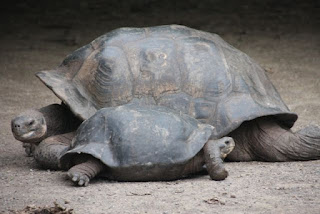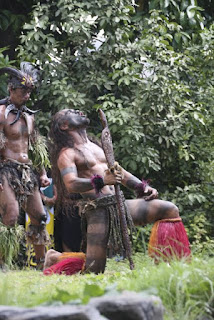Just on the southern horizon as seen from Nuku Hiva is Oa Pou and it sings a siren song. So we sail down there one day and walz right into the capital of Hakahau (pop. 2,110) where we are the only cruisers at least for one night. Soon we are comfortable with the anchorage and the people.
Did I mention siren song? My first view of these peaks was from ten miles away.
The sunrise painted them with a special palette and I lost my heart to Oa Pou.
There is a water spigot on the beach which we use for laundry. We are washing our dirty laundry in a public park when two gendarmes approach striking terror into our hearts. Which one of our offenses did they discover? They ask us in English to move our boat to make room for Aranui, the supply ship due the next day. Breathing a big sigh of relief, we move Kalliope and Aranui doesn't run over us and everybody is happy.
A collision with Aaranui is to be avoided by all means.
There is a derelict building near the spigot where we were apprehended by the gendarmes. Some years back it was painted brown but the painter considerately left this older piece of graffiti exposed.
Fresh supplies from the ship make the islanders happy so they host a reception and throw a party for the few guests that travel on the supply ship.
After the visitors are fed and offered local crafts at the park they are invited to walk a couple blocks to a historic site for traditional music and dance.
I give this band three stars.
She looks like she has been practicing and
will lead the troupe in six or eight years.
It is hard to believe these are store clerks, dignified government officials, nurses and horse wranglers the other six days of the week. They work out their aggression through their dances which historically emphasize the warrior role. Four stars.
This guy concludes a dance depicting a successful battle with a celebratory howl.
We have seen a couple of these carved wooden ships prow pulpits. This is my favorite.
We visit this Catholic Church at 10:00 Sunday, after the service I guess, for there is not a soul around. However someone decorated the altar with beautifully woven fresh palm fronds.
We move to the next bay with the almost identical name of Hakahetau where a beachfront park becomes our dinghy landing. The designer made maximum use of these natural rock outcrops which even include a little geyser powered by the waves.
We have no photo of the geyser but here is is the rock.
The Marquesians must think it gauche to advertise nature's natural attractions with neon signs and tee shirt shops and Deb and Gregg often have difficulty finding them. With only a couple false starts we find the perfect waterfall and skinny dip pool.
I can't believe how few people visit this place.
Our search is rewarded. Five stars.
Deb worked really hard and threw out dozens of photos to get this one.

























































